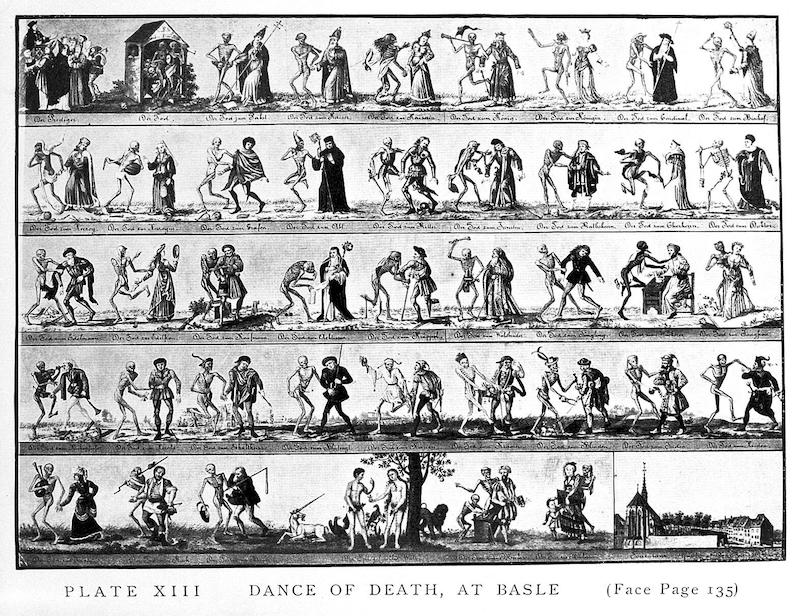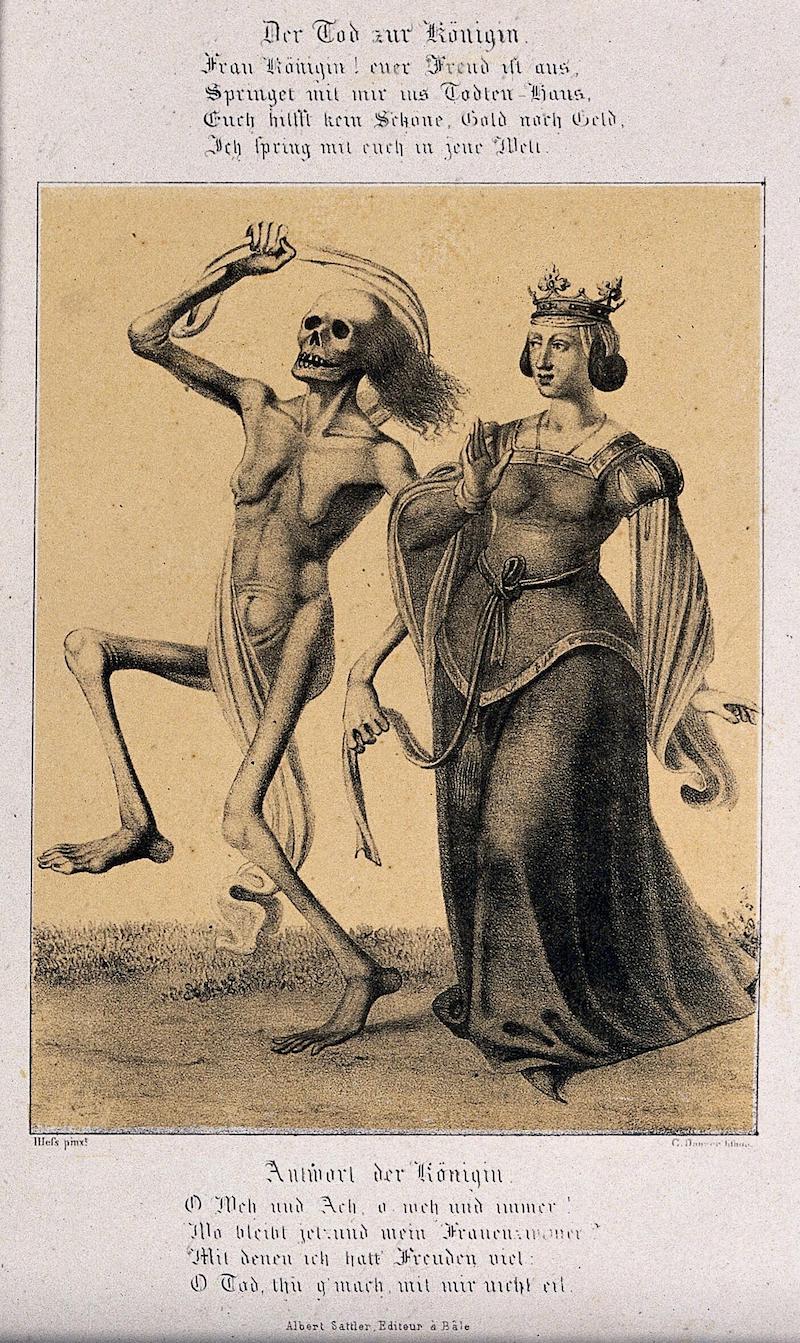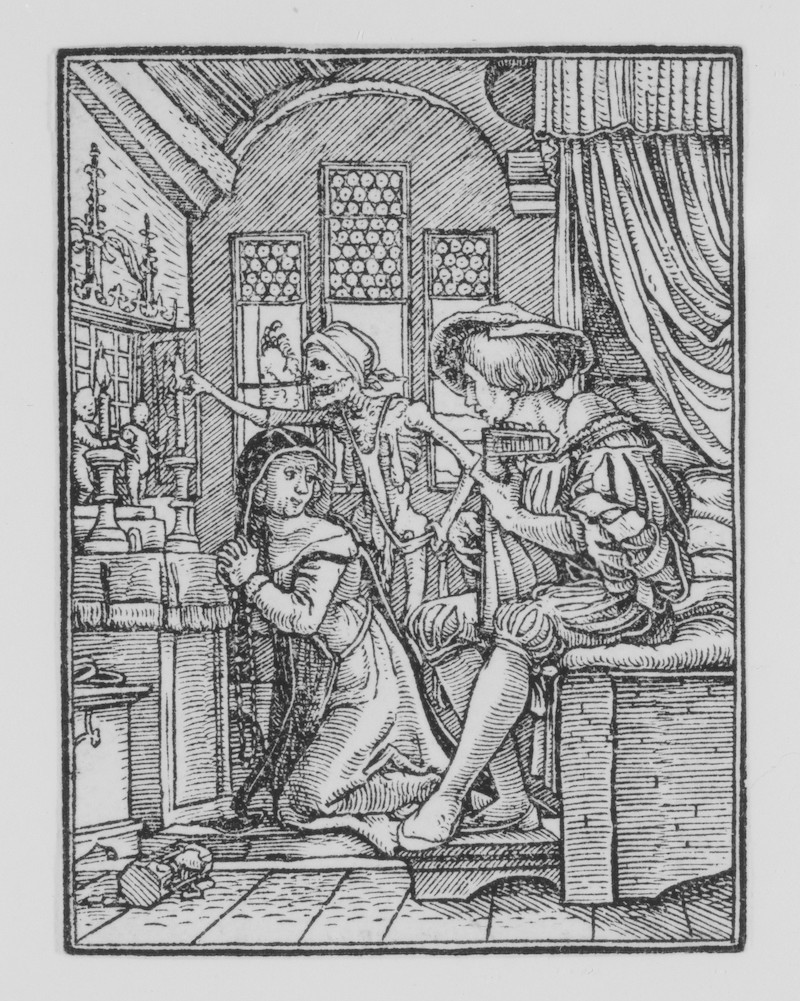Personified Death in Early Modern Art and Literature
Early modern Europe experienced an increased preoccupation with death, which appeared frequently in literature and art, including the Memento Mori. When personified, Death took many forms, though the image of a skeleton (assumed male through lack of feminine characteristics) and the eroticized Death-as-lover were common treatments.
Even for someone writing in early modern England, Hester Pulter was particularly concerned with death, which is referenced in more than a third of the 120 poems in her manuscript. Like her contemporaries’ descriptions, Pulter’s Death varies widely. While usually genderless, in the six poems where Death is given pronouns, three are feminine (“The Welcome [1]”, Dear God, Turn Not Away Thy Face20, and My Soul, Why Art Though Full of Trouble?40) and three are masculine (Aurora [1]3, The Center30, and The Turtle (Emblem 8)74).
The following are some popular literary and pictorial depictions of personified Death in the period.

Dance of Death, at Basle. As reproduced in Raymond Crawfurd’s Plague and Pestilence in Literature and Art (1914). Image courtesy of Wellcome Collection. Attribution 4.0 International (CC BY 4.0).
The Basle Dance of Death (ca. 1440) offers perhaps the most important and influential images of Death of the period. It is comprised of a series of connected images in which Death, in different guises, is depicted visiting various people: the Death figure approaching the queen has long hair and breasts, the one approaching the knight is wearing armour, the figure approaching the blind man has a moustache and beard, and the one approaching the woman and child is wearing a veil. While these details might suggest that Death’s appearance changes according to the person whom it visits, that is not strictly true; personified Death took many forms across early modern Europe and even within the same work, as above.
These figures were painted life-size in a shed of the Dominican convent at Basle by an unknown artist. Although the original painting was destroyed in the early-nineteenth century, reproductions are extant, as are some wall fragments, preserved in Basel’s history museum.

G. Danzer after H. Hess, The dance of death at Basel: death and the queen. Lithograph. Image courtesy of Wellcome Collection. Attribution 4.0 International (CC BY 4.0).
Holbein’s Dance of Death inspired many recreations, including this lithograph designed by Hieronymus Hess (1799–1850). While this printing is not contemporary, its high-quality image offers an opportunity to imagine some of the details of the original images at Basle. Like the Basle version, the Death that visits the queen is depicted as having feminine characteristics, including breasts and long hair.

Hans Holbein the Younger, “The Nun, from The Dance of Death” (ca. 1526, published 1538). Image courtesy of The Metropolitan Museum of Art, New York.
The above woodcut was likely designed by Hans Holbein the Younger (1497–1543) and printed by Hans Lützelburger in the early-to-mid sixteenth century as a part of a series of The Dance of Death. In “The Nun,” Death, who is portrayed as having drooping breasts, visits a nun in her private room. While the nun is presumably praying, kneeling at an altar with her hands folded, her attention and gaze are turned, fixated on the young male lutenist in the foreground. In the background, Death extinguishes the nun’s candle or life-light.
Pulter was clearly a reader of Donne’s poetry, echoes of which can be found throughout her manuscript: as Wendy Wall notes in her Curation Talking to Death, the language of The Eclipse1 resonates Donne’s “Death be not proud”. While the speaker of Pulter’s “The Welcom” is more sympathetic towards Death than Donne’s, the conclusion is much the same. In Donne’s poem, the speaker reveals the irony of a Christian death, which is the beginning of eternal life—the death of Death. Likewise, in Pulter’s poem, the speaker anxiously anticipates dying and finally “bid[ding] adieu” to Death, releasing her soul from the confines of the material world into eternal life.
- Death be not proud, though some have called thee
- Mighty and dreadfull, for, thou art not soe,
- For, those, whom thou think’st, thou dost overthrow,
- Die not, poore death, nor yet canst thou kill mee;
- From rest and sleepe, which but thy pictures bee,
- Much pleasure, then from thee, much more must flow,
- And soonest our best men with thee doe goe,
- Rest of their bones, and soules deliverie
- Thou art slave to Fate, chance, kings, and desperate men,
- And doth with poyson, warre, and sicknesse dwell.
- And poppie, or charmes can make us sleepe as well,
- And better then thy stroake; why swell’st thou then?
- One short sleepe past, wee wake eternally,
- And death shall be no more, death thou shalt die.
Early modern literature, like Pulter’s “The Welcome [1]”, is often ambivalent about death. Here, the speaker in Herbert’s poem “Death” reflects on how Christ’s sacrifice transformed Death and death from hideous and sad to beautiful and desirable.
¶ Death.
- DEath, thou wast once an uncouth hideous thing,
- Nothing but bones,
- The sad effect of sadder grones:
- Thy mouth was open, but thou couldst not sing.
- For we consider’d as at some six
- Or ten yeares hence,
- After the losse of life and sense,
- Flesh being turn’d to dust, and bones to sticks.
- We lookt on this side of thee, shooting short;
- Where we did finde
- The shells of fledge souls left behinde,
- Dry dust, which sheds no tears, but may extort.
- But since our Saviours death did put some bloud
- Into thy face;
- Thou art grown fair and full of grace,
- Much in request, much sought for, as a good.
- For we do now behold thee gay and glad,
- As at dooms-day;
- When souls shall wear their new array,
- And all thy bones with beautie shall be clad.
- Therefore we can go die as sleep, and trust
- Half that we have
- Unto an honest faithfull grave;
- Making our pillows either down, or dust.